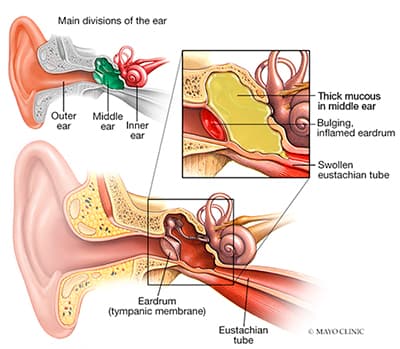Otolaryngology (ENT)
Ear Infection
 An ear infection is an infection of the middle ear, the air-filled space behind the eardrum that contains the tiny vibrating bones of the ear. Children are more likely than adults to get ear infections due to the size and shape of their eustachian tubes and because their immune systems are still developing.
An ear infection is an infection of the middle ear, the air-filled space behind the eardrum that contains the tiny vibrating bones of the ear. Children are more likely than adults to get ear infections due to the size and shape of their eustachian tubes and because their immune systems are still developing.
Signs and symptoms
The symptoms of ear infections can include:
- Ear pain, especially when lying down
- Tugging or pulling at an ear
- Fussiness
- Trouble hearing or responding to sounds
- Loss of balance
- Fever of 100 F or higher
- Drainage of fluid from the hear
- Headache
- Loss of appetite
Signs and symptoms of an ear infection can indicate several conditions. It is important to see a healthcare provider to get an accurate diagnosis and prompt treatment. Call our healthcare team if:
- Symptoms last more than a day
- Symptoms are present in a child less than 6 months of age
- Ear pain is severe
- Your infant or toddler is sleepless or irritable after a cold or upper respiratory infection
- You notice discharge of fluid, puss or bloody fluid from the ear
Causes
An ear infection is caused by bacteria or virus in the middle ear. This infection often results from another illness — cold, flu or allergy — that causes congestion and swelling of the nasal passages, throat and eustachian tubes. Swollen eustachian tubes can become blocked, causing fluids to build up in the middle ear. This fluid can become infected and cause the symptoms of an ear infection.
In children, the eustachian tubes are narrower and more horizontal, which makes them more difficult to drain and more likely to get clogged.
Treatment
Symptoms of ear infections usually improve within the first couple of days, and most infections clear up on their own within one to two weeks without treatment. The American Academy of Pediatrics and the American Academy of Family Physicians recommend a wait-and-see approach as one option for:
- Children 6 to 23 months with mild middle ear pain in one ear for less than 48 hours and a temperature less than 102.2 F
- Children 24 months and older with mild middle ear pain in one or both ears for less than 48 hours and a temperature less than 102.2 F
Some of the following methods are effective in relieving symptoms:
- Apply a warm cloth to the affected ear
- Take over-the-counter pain medication such as ibuprofen (Advil) or acetaminophen (Tylenol)
- Take over-the-counter ear drops to relive pain
After initial monitoring, a doctor may recommend antibiotic treatment. Even after symptoms have improved, be sure to use the antibiotic as directed. Failing to take all medication can lead to a recurring infection and resistance of bacteria to the antibiotic medications.
Ear tubes
If a child has persistent ear infections or fits certain criteria, ear tubes may be recommended. Ear tubes are tiny, hollow cylinders, usually made of plastic or metal, that are surgically inserted into the eardrum. An ear tube creates an airway that ventilates the middle ear and prevents the accumulation of fluids behind the eardrum.
Ear tubes are often recommended for children who have persistent fluid buildup behind the eardrum, especially if the condition causes hearing loss and affects speech development. Ear tubes may also be recommended if your child gets frequent ear infections.
Most ear tubes fall out within six to nine months, and the holes heal shut on their own. Some tubes need to be removed, and some holes may need to be closed surgically.
Children who have frequent ear infections or who have persistent fluid in the middle ear will need to be monitored closely. Talk to one of our ENT specialists today to discuss the best monitoring and treatment plan for your child.